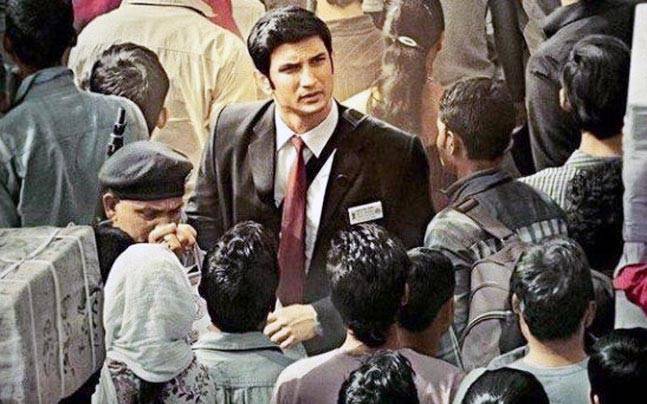By Rahul Desai
MS Dhoni: The Untold Story is a terrific hagiography – a film made of, by and for cricket fans. Or more specifically, Indian cricket fans. Or even more specifically, Dhoni fans. Mahi-maniacs (sounded better in my head). Which is effectively an entire country, making this a very smart move by director Neeraj Pandey. More than half the battle is won with his choice of subject. There’s little more he needs to do, except perhaps integrate a hardworking Sushant Singh Rajput into famous match footage. I’d imagine Pandey would be top of the list to make a film on Salman Khan, starring a CGI-altered Salman Khan. After all, it takes a special kind of talent to expertly edit out all the pessimism and unsavoury moments from a true story. Fortunately, in Dhoni’s case, after all that, there’s still a story to tell.
His film on India’s second greatest cricket captain ever – Dada fans, please rise – shows us everything we hoped to see about India’s best-known underdog. It shows us everything we thought we knew about the man’s temperament and struggles. It’s like a big-budget all-encompassing docudrama, showing us our favourite parts of a career that is full of such parts (at least till 2011). It doesn’t sully anybody, and it doesn’t point fingers. It doesn’t stay on a face or scene long enough for you to form your own opinion about it. Like many films about superheroes (read, any Hindi film about a famous person), the dramatic license sets in early, starting right from the quintessential birth scene in a hospital. All those lonely sweaty laps around grounds and thousands of hits in the nets are replaced by (the more cinematically watchable) ‘raw-talent’ montages. “Ladka aage badhega,” we hear, in various wise tones and dialects, before being shown this ladka paving his own way. There are literally no bad people – just people who’re products of their own small-town and big-city environments. There is no tense music. There are only crescendo-heavy rising-from-ashes scores – it tells us constantly that something heroic is around the corner – punctuating every other stride and second. It does involve you for majority of its 190 minutes (believe it), which is a lot more than can be said about other sports hagiographies (Bhaag Milkha Bhaag, Mary Kom, Azhar) of our time.This has all the traps and beats of a posthumous celebration on screen – except that Dhoni is alive, and still the captain of the ODI team. Lest we forget.
It tells us everything we want to hear, at a late stage of his career that makes it increasingly easy to forget what Dhoni has meant for cricket. For small towns. For unconventionality. For dreams and sheer will power. Remember: he was so outrageous an idea in the 1990s — a keeper who could actually bat more than he could keep, a la Adam Gilchrist — that his achievements were often dismissed by officials (“how dare he — that long hair, those un-textbook-like shots?!”) who couldn’t come to terms with this concept. Those were the days of Nayan Mongia and Kiran More (who makes a special appearance here, ironically), players selected as purist keepers with their batting skills being a bonus. Dhoni had to not only make it on potential, but change a mentality, an entire system of thinking — some of which is demonstrated in superficial flashes here.
The film, however, unapologetically designs itself as a dramatic reminder, not a work of art or gritty storytelling. And most of us love reminders, irrespective of how long-drawn, stretched, hero-worshipping, black and white, saccharinely sweet and blindingly bright they tend to be.
Contrary to what the makers claim in pre-release interviews, their film unabashedly pays tribute to Mahendra Singh Dhoni. To his support system. To his life. To his little neighbourhood in the town of Ranchi. To his school. To all those perceptive coaches (Rajesh Sharma, as the chap who convinced little Dhoni to ditch his goalkeeping gloves for wicketkeeping gloves, is so inclusive) and unconditional well-wishers. To every face that ever believed in him. Every actor is competent, all veteran masters of beaming those looks of tearful pride. Everyone is a parent. “This is our boy,” they all go, and you nod in agreement. Our boy, in our film, about our cricket, for our country. There’s nothing wrong with this – Who doesn’t like to see happy and inspiring things? Who doesn’t like to share the sorrows and joys of an icon that stands for everything we dreamed of becoming? Who doesn’t like cricket – the blood, sweat and sacrifices it takes to hold a bat, ball or keeping gloves at the highest level?
You can sense it, all along, that the filmmaker is feeding us the story about a great player, not the great story behind a player. There are ups, downs, some tragedy, some demons in the mind, but we’re kept at a safe distance from the politics, griminess and power-play that probably delayed Dhoni’s arrival on the world stage; that probably laid the foundation to “Captain Cool” — a man who is, at times, annoyingly unruffled almost to a fault. Instead, there’s that frustrating period of his life – as a ticket collector at Kharagpur railway station for two full years – the only stage where I was yanked out of the aura, and sympathised with a confused boy instead. It was the only time I hoped he found his way. The rest of the way is paved out very dutifully by the makers. There’s also the novelty of learning what was actually going through his mind during his debut ODI century (148 against Pakistan at Vizag); it may have been a girl (actress Disha Patani, who can easily be mistaken for Shraddha Kapoor), which makes him familiarly human and boyish for these bashful but distinctly filmy scenes. There is nothing else left to our imagination, because heaven forbid what our minds can get up to. Most of us love watching behind-the-scene footage of dressing rooms. We love watching that pre-performance segment on reality shows about the participant’s rags-to-riches journey to the stage. This film is that segment, only blown into more than three hours.
But this is not a biopic. Far from it.
At times it pretends to be one, but then it goes back to showing us how hard Mahi hits the ball. How far he hits it. How sincere he is. How calm and composed he can be. How he learns the helicopter shot from a friend who was trying to impress a girl. How he came up through the ranks later than his contemporaries like Yuvraj Singh for no real reason.
I enjoyed watching most of this, manipulated to an extent where I decided I wouldn’t blame his diminishing abilities in 2016 anymore. I didn’t need reasons, for the same reason I don’t want to know the details of what the BCCI is really up to. I looked for a film in their golden-eyed boy instead. Rajput is uncanny in some sequences, from some angles, and with some phrases and mannerisms. His physicality and attention to shot-making makes the cricket sequences look a little better than they are. He makes this role his own, despite having to be someone who has been scrutinised to the point of mimicry. I’ve never quite warmed up to the actor, though he seems to have done his homework here – at least as far as how we perceive Dhoni as a person. We’ve always been led to believe from his interviews that “cricket is just a game” for him, but it’s nice to learn WHY exactly he believes this. When cricket was more than a game for him, he almost lost everything — including his sanity. This is simply my interpretation. Not that we’ve learned anything more from this film. We’re not supposed to.
The problem again lies in the alleged biopic template. At this stage in Indian cinema, one can easily replace one uplifting training montage and two life-changing career sequences from one film with another, and it’d make absolutely no difference. Dhoni simply does these things a little better than its predecessors (just like the player finished innings a little better than his), still content to lie back on its unprecedented access. Its achievements. Its production.
I lived some memorable sporting moments again on the big screen. But I was also keenly aware that if, for some absurd reason, I wasn’t an avid cricket watcher, this film is an utterly average piece of work. It isn’t an exemplary piece of storytelling. Just like Pandey’s action drama Baby was, if you looked past its jingoistic themes and chest-beating ideology. If I didn’t already know of Indian cricket’s timeline over the last decade, I’d be completely lost, wondering why it’s all being skimmed over in a hurry. The makers simply assume that we know enough for them to rely solely on archival rushes. If this weren’t a real life with real key events (you keep wondering how the real Dhoni would have reacted or sounded when put in un-Dhoni-like situations), I’d be rolling my eyes at how songs just pop out of nowhere to demonstrate the protagonist’s love interests. Basically, if I didn’t care for Dhoni being the Dhoni, Neeraj Pandey’s is an unremarkable, long, indulgent, safe and greedy film. A film that works only for what it represents, not for what it is. The only thing untold about it is that there hasn’t been an official Dhoni film before this one. In essence, it has all been told before in many ways.
Then again, if you’re a devotee, nothing else matters.







Leave A Comment
You must be logged in to post a comment.